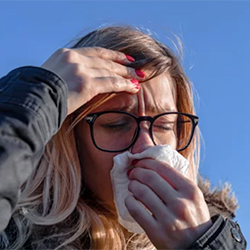By Ethan Covey
Increasing U.S. influenza immunization rates, combined with the use of more effective vaccines, may be necessary to improve health outcomes and avoid saturation of healthcare resources during a scenario of co-circulation of influenza and COVID-19, according to data presented at the OPTIONS XI conference in Belfast, Northern Ireland (abstracts AOXI0410 and AOXI0397).

The studies examined the effect of immunization rates and effectiveness on co-circulation scenarios.
“[The studies] demonstrate the significant burden influenza places on healthcare resource use and vulnerable populations, as well as the impact that cell-based and adjuvanted influenza vaccines can have in reducing the burden of seasonal influenza,” said Gregg Sylvester, MD, the chief health officer for CSL Seqirus. “These abstracts showcase the need to increase the current U.S. flu immunization rate to improve health outcomes and avoid saturation of hospital system resources, especially ICU hospital bed saturation during a co-circulation scenario.
“These studies are important as the COVID-19 booster program is concurrent with the 2022-23 influenza season, and the development of education, training and messaging is necessary to improve co-administration rates,” Dr. Sylvester added.
During the 2021-2022 influenza season in the United States, the overall immunization rate dropped to 45%, a rate below pre-pandemic levels (https://www.cdc.gov/flu/fluvaxview/coverage-2021estimates.htm). To estimate the impact of this reduced rate on hospital resources when influenza and COVID-19 viruses are co-circulating, researchers employed a predictive modeling study that assumed immunization with the standard-dose, egg-based quadrivalent influenza vaccines for all ages, a total number of 1 million acute hospital and 100,000 ICU hospital beds in the United States, and a regular occupancy rate of 70% related to other diseases.
The model used the current U.S. influenza immunization rate of 45% and an average vaccine effectiveness rate of 42% based on estimates from CDC reports for the last 10 seasons, as well as the COVID-19 variants alpha, delta and omicron.
The model estimated that the number of acute hospital and ICU hospital beds used for influenza would be 183,778 and 27,891, respectively, during a high-incidence influenza season, and 57,521 and 8,850 for a low-incidence season. During a COVID-19 pandemic setting, this would generate significant pressure on the U.S. hospital system, especially in a high-incidence season, and would saturate the number of ICU hospital beds, which are assumed to be at 1 million and 100,000, respectively.
To evaluate how the use of more effective vaccines may help, the researchers compared a scenario in which all people are immunized with standard-dose egg-based vaccine (QIVe) with a scenario in which those who are between 6 months and 64 years of age are immunized with cell-based quadrivalent influenza vaccine (QIVc) and those 65 and older are immunized with an adjuvanted quadrivalent vaccine (aQIV).
They found that, compared with QIVe, immunization with QIVc or aQIV would prevent utilization of 24,010 acute hospital beds and 3,601 ICU hospital beds within a high-incidence influenza season, and 17,329 acute hospital beds and 2,659 ICU hospital beds within a low-incidence influenza season.
However, the researchers concluded that this reduction of inpatient services would still not be enough to avoid saturation of ICU resources due to high bed demand related to COVID-19. As a result, both studies found that preventing the oversaturation of hospital resources would require increasing U.S. influenza vaccine rates to 60% or higher.
“While we’ve made much progress in addressing influenza, its burden and associated unmet medical need still exists,” Dr. Sylvester said. “These studies reinforce the importance of increased influenza vaccination rates and the impact that cell-based and adjuvanted influenza vaccines can have in reducing the burden of influenza.”
The studies were performed by CSL Seqirus, which makes a broad range of influenza vaccines.




